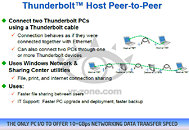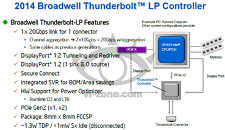- Joined
- Oct 9, 2007
- Messages
- 47,528 (7.48/day)
- Location
- Hyderabad, India
| System Name | RBMK-1000 |
|---|---|
| Processor | AMD Ryzen 7 5700G |
| Motherboard | ASUS ROG Strix B450-E Gaming |
| Cooling | DeepCool Gammax L240 V2 |
| Memory | 2x 8GB G.Skill Sniper X |
| Video Card(s) | Palit GeForce RTX 2080 SUPER GameRock |
| Storage | Western Digital Black NVMe 512GB |
| Display(s) | BenQ 1440p 60 Hz 27-inch |
| Case | Corsair Carbide 100R |
| Audio Device(s) | ASUS SupremeFX S1220A |
| Power Supply | Cooler Master MWE Gold 650W |
| Mouse | ASUS ROG Strix Impact |
| Keyboard | Gamdias Hermes E2 |
| Software | Windows 11 Pro |
Intel is continuing on its mission to establish Thunderbolt as the next universal device interconnect standard, despite steep competition from the 5 Gb/s USB 3.0, the upcoming 10 Gb/s USB 3.1, and stringent validation and licensing barriers on its own end. To that effect, the company outlined its mainstream Thunderbolt controller, which it plans to launch some time in 2014. The company is planning two major introductions to the standard, to help it compete against USB - power delivery, and ad-hoc (peer-to-peer) networking.
The controller, Broadwell Thunderbolt-LP, isn't designed too differently from what's available in the market. It handles a 20 Gb/s Thunderbolt link by aggregating two 10 Gb/s channels, relays DisplayPort 1.2 from the system's graphics device, and connects to the rest of the system over PCIe 2.0 x2. The chip is built in the 8 x 8 mm package, and features operational and idle TDP ratings of 1.5W and 1mW, respectively. The changes Intel is making to the standard will enable power delivery of up to 53W over a standard tethered cable. That's enough power to run a drive dock with up to six 3.5-inch hard drives, or a small (<24-inch) flat-screen monitor. The other big feature is ad-hoc networking, which enables people to set up peer-to-peer 20 Gb/s connections between two PCs much in the same way they did with USB and RS232, back in the day. While it's no Ethernet replacement, it could prove useful in certain environments, such as content-creation. Intel is expected to make some Thunderbolt-related announcements at CES, next January.


View at TechPowerUp Main Site
The controller, Broadwell Thunderbolt-LP, isn't designed too differently from what's available in the market. It handles a 20 Gb/s Thunderbolt link by aggregating two 10 Gb/s channels, relays DisplayPort 1.2 from the system's graphics device, and connects to the rest of the system over PCIe 2.0 x2. The chip is built in the 8 x 8 mm package, and features operational and idle TDP ratings of 1.5W and 1mW, respectively. The changes Intel is making to the standard will enable power delivery of up to 53W over a standard tethered cable. That's enough power to run a drive dock with up to six 3.5-inch hard drives, or a small (<24-inch) flat-screen monitor. The other big feature is ad-hoc networking, which enables people to set up peer-to-peer 20 Gb/s connections between two PCs much in the same way they did with USB and RS232, back in the day. While it's no Ethernet replacement, it could prove useful in certain environments, such as content-creation. Intel is expected to make some Thunderbolt-related announcements at CES, next January.


View at TechPowerUp Main Site




